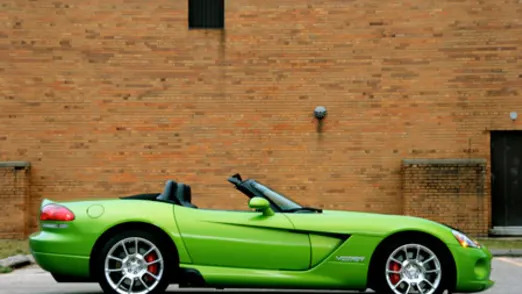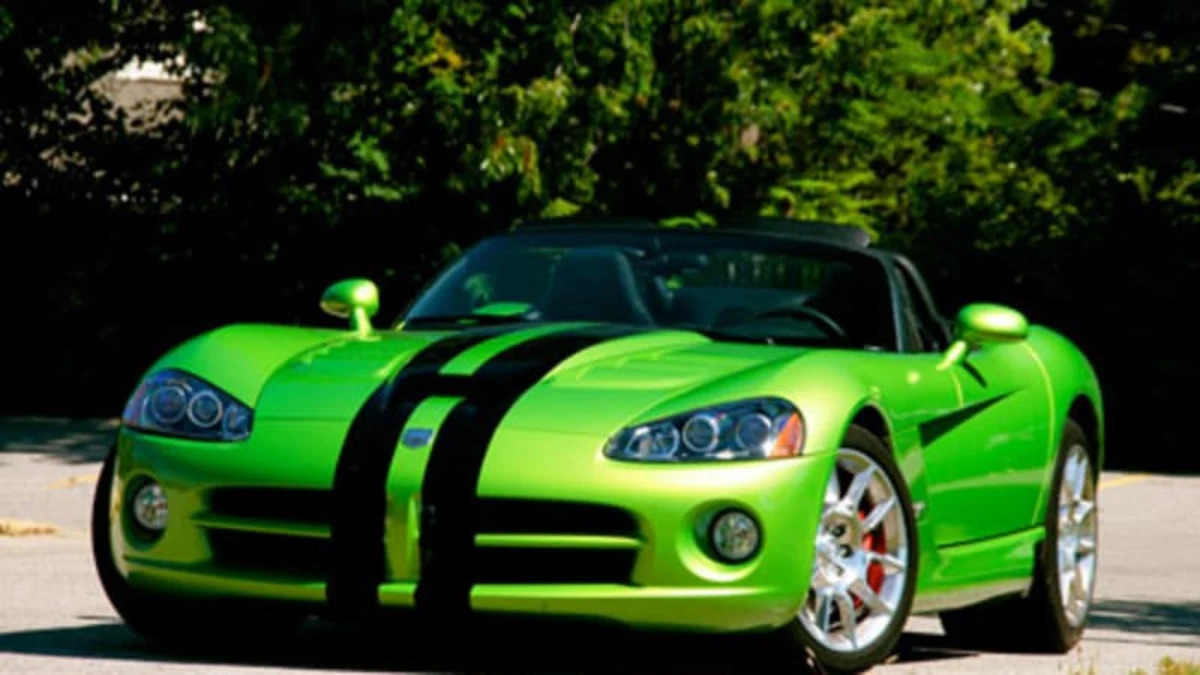2008 Dodge Viper SRT-10 – Click above for high-res image gallery
Next January's Detroit Auto Show will mark the 20th anniversary of the Viper's debut as a concept. Back then, every car in Chrysler's lineup was still derived from the K-Car. The K-cars saved Chrysler from the jaws of bankruptcy, but an executive named Lutz decided the automaker needed a new halo car to generate some excitement as a new decade dawned. Another old guy named Carroll Shelby was sprucing up Daytonas and Omnis at the time, so they decided to revive an idea from earlier in his career. Together they created a minimalistic two-seater with a humongous engine that became an instant American classic. That basic premise lives on today in the 2008 Dodge Viper SRT-10 with only slightly less minimalism. Read on to find out what it's like to live with a snake for a week.
Photos Copyright ©2008 Sam Abuelsamid / Weblogs, Inc.
Chrysler gave us the keys to a convertible Viper SRT-10 in what is arguably the best color ever applied to the V10 sports car. Snakeskin Green was a new color added for the 2008 model year update and our tester also had the optional painted-on bumper to bumper black stripes. Everyone who laid eyes on it loved the green and it literally shimmered in sunlight. Since we had the convertible instead of the coupe and it wasn't raining, the first thing to do was drop the top. Aside from having to open the trunk, lowering the top of a Viper is nearly as simple as that of a Miata.

A single latch in the middle of the windshield header releases the roof and it drops down in one smooth motion. Close the the trunk and you're done. There are no motors or actuators involved, and the top stows and raises without having to press anything down or snap anything in place. It's very simple, just like everything else about the Viper.
This iteration of the Viper was developed when Chrysler was owned by Daimler, and in many ways it's the polar opposite of a Mercedes-Benz. While cars like the AMG S63 and the SL550 are both ridiculously fast, they are also enormously complex. Even with all the power they possess, stability control systems tend to sap away their liveliness and, with everything actuated electronically, the cars feel synthetic.


There is nothing synthetic about a Viper. It is one of the loudest, most raucous cars in the world. With the top up, you have to duck down to get in as you step over the wide sill. With the top down, you just step over and fall into the seat. The Corvette ZR1 we recently drove has one serious flaw: its seats. Here the Viper wins hands down. These SRT seats are well bolstered and hold you firmly in position. Unfortunately, the Viper's packaging means the position of the steering wheel and pedals relative to that amazing seat is slightly less than ideal.


The Viper's 600-hp 8.4L V10 is set well back in the chassis with its 6-speed gear box directly behind it. That means there's a wide tunnel that offsets the pedals slightly to the left. The steering wheel, however, is offset slightly to the right of the seat's center line. None of the offsets are enough to detract from operating the car, but they are noticeable. The Viper was one of the first cars offered with adjustable pedals and they are fortunately retained on the current model. The shift lever, meanwhile, sits directly atop the gearbox and works best with deliberate but not forced manipulation. Like the ZR1, the Viper has a twin disc clutch that provides the necessary torque transmission capacity without requiring excessive force on the clutch pedal.

The original 1989 Dodge Viper concept
One of the characteristics we mentioned recently about the Porsche Carrera was how small it felt in comparison to other cars. Precisely the opposite is true of the Viper. The Dodge and Porsche only differ in overall length by 1.3 inches yet the Viper feels huge in comparison. Its hood stretches way out in front while the Porsche seems to disappear around you. The feeling of driving these two sports cars couldn't be more different.
The video meant to be presented here is no longer available. Sorry for the inconvenience.
Two decades ago when Lutz and company conceived the Viper, they deliberately kept it minimal going so far as to use side curtains instead of windows and an incredibly flimsy fabric top. Only when the GTS coupe debuted in 2006 did they even add exterior door handles and actual windows. Even today, any electronic driver assistance is limited to just anti-lock brakes. The Viper has neither traction or stability control, which means you can light this beast up any time you feel the urge. However, having 600 horsepower and 560 lb-ft of torque at your command on the street requires extreme caution if you intend to keep it out of the ditch.


Besides smoke, the Viper also generates a lot of heat. The massive hood vents that were added for 2008 are definitely functional. You can see heat waves emanating from the engine compartment while sitting at a red light. When a redesigned Viper debuted in 2003, Dodge reverted back to side exhausts like on the early cars. Along with those came a large warning sticker on the rear of the door openings that cautions occupants to take care when exiting so as not to burn their legs on the hot sill.

Fortunately, the huge Michelin Pilot Sport tires provide grip commensurate with their size. Compared to the new Pilot Sport 2s on the ZR1, the Viper tires don't break away quite as progressively, but they are still fairly manageable. Even without fancy stuff like magneto-rheological shocks or active steering, the Viper's suspension is remarkably well sorted. The chassis feels stiff and solid and never exhibits signs of flexibility. Cowl shake was non-existent even on what they claim is a "road" in front of my son's middle school. Speaking of which, dropping off your 13-year-old son at school in a Snakeskin Green Viper is just the way to get on his good side.
No one driving a Viper will ever confuse it for a luxury car. You feel every interaction between the road and the rubber, and that's a good thing for a car like this. The ride is fairly stiff, more so than a new ZR1 with its MR damping system in Comfort mode. The Viper is not a car that should be chosen for daily driving duties, but it does a decent enough job that you won't mind taking it out to for errands when the mood strikes you.




The Viper is a toy, and in many ways it is the anti-Tesla Roadster. Like the Roadster (at least when the updated Drivetrain 1.5 is installed), the Viper is absurdly fast and has limited utility. But where the Tesla is whisper quiet, the Viper is constantly rumbling along. At low speeds and part throttle it doesn't sound particularly impressive, but it absolutely roars when opened up. Visibility is mediocre with the top up, and even with the top down the windshield header is rather low and makes it difficult to see traffic lights. Without any wind blocker available, there is plenty of buffeting in the cockpit even with the side windows up.

But none of this matters much because the Viper is about the open road where such mundane concerns are meaningless. Put on a ball cap, or better yet a helmet, and take the Viper out to play. At $93,000 including a gas guzzler tax and those $3,000 stripes, you won't really care about its thirst for premium gasoline anyway.
Photos Copyright ©2008 Sam Abuelsamid / Weblogs, Inc.



Sign in to post
Please sign in to leave a comment.
Continue